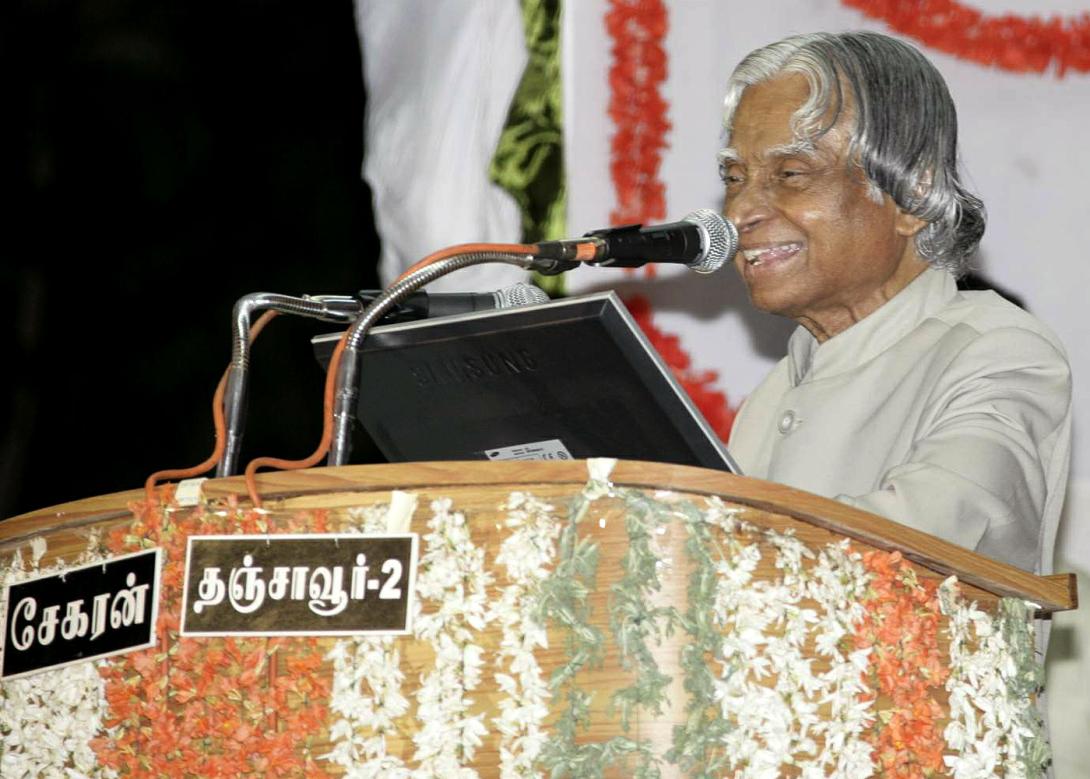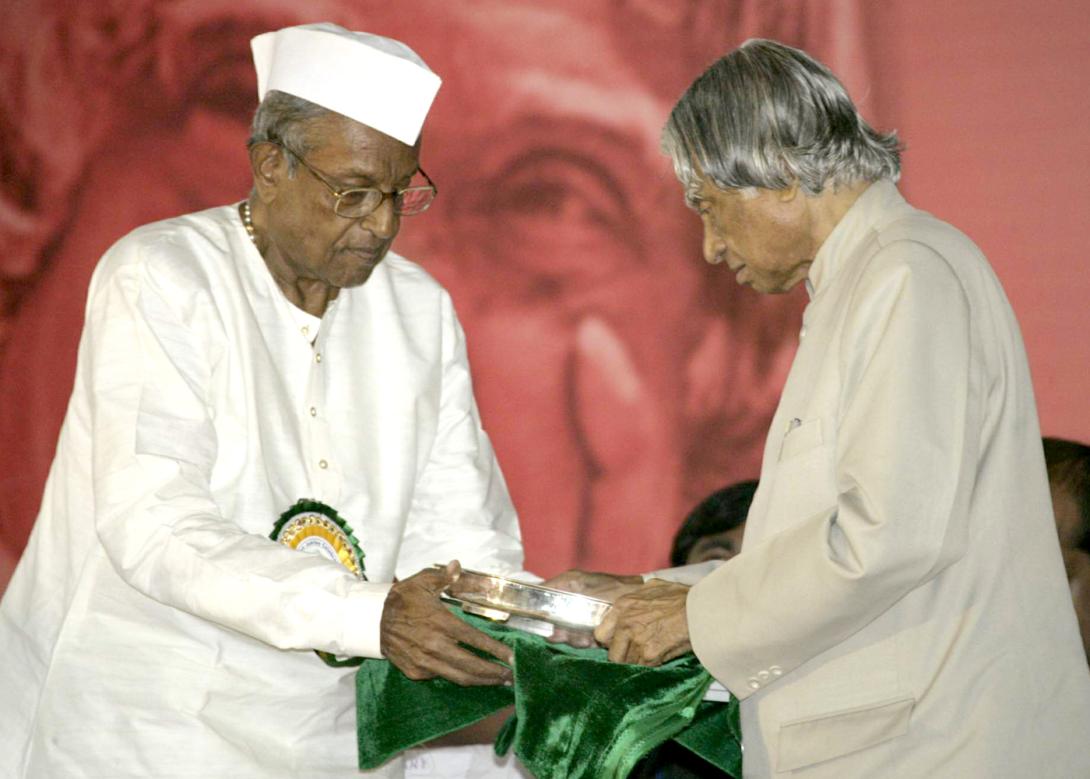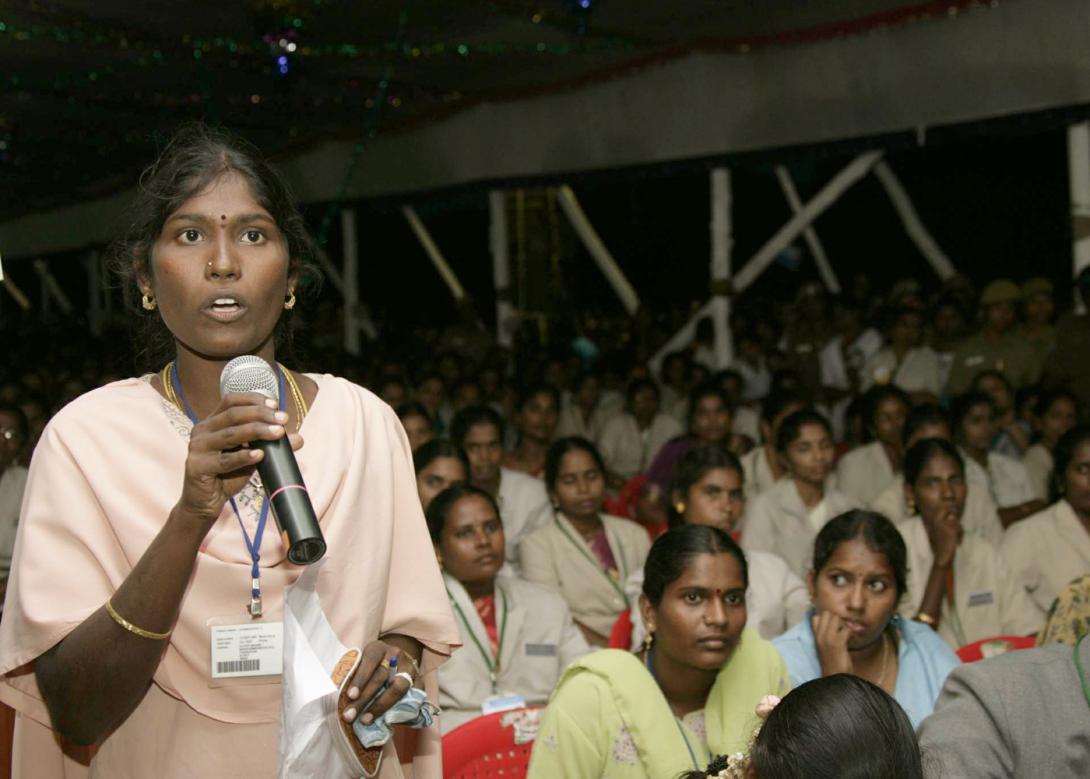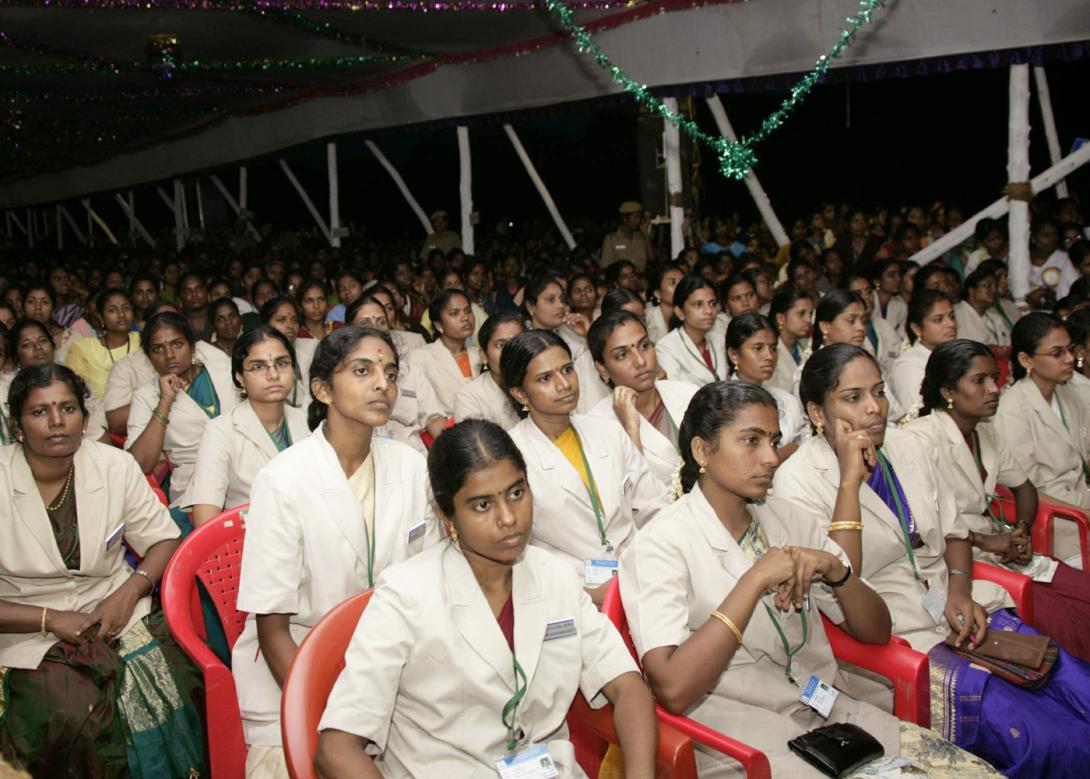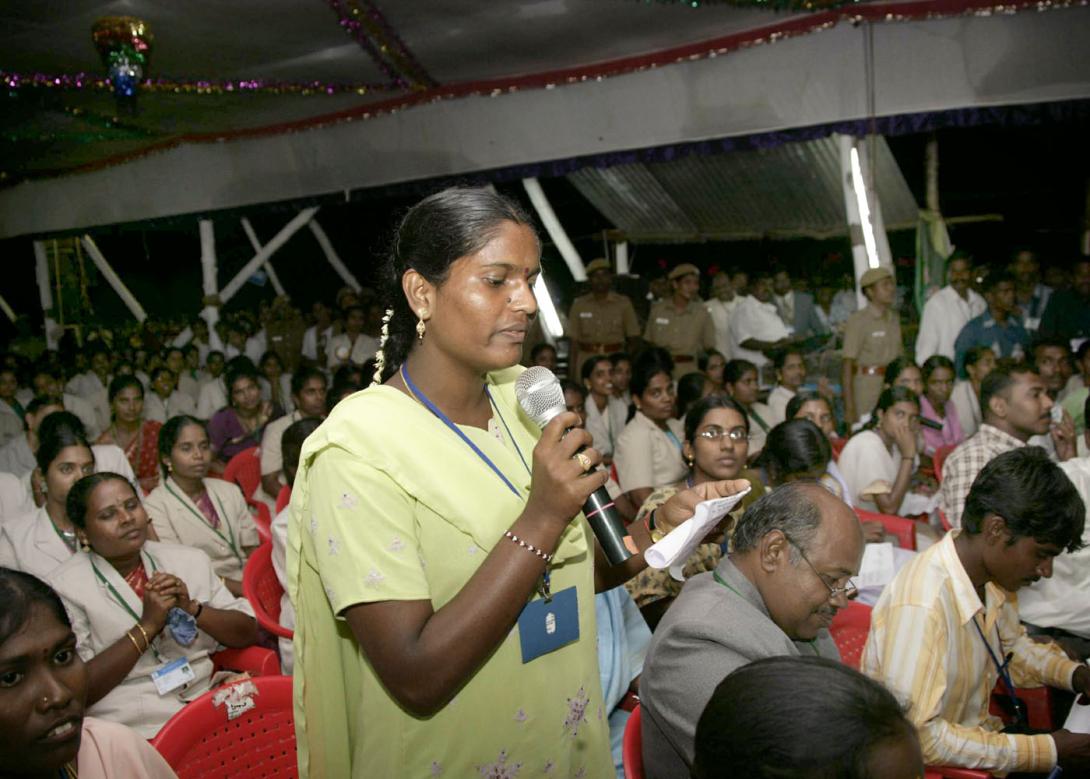Address and Interaction With Students of a.veeriya Vandayar Memorial Sri Pushpam College, Thanjavur, Tamil Nadu
Thanjavur : 24-10-2006
Youth and National Development
I am delighted to be here and interact with the students of A. Veeriya Vandayar Memorial Sri Pushpam College, Thanjavur which is celebrating Golden Jubilee this year. The strength of a nation comes out of economic growth and the ability to defend itself. Hence progress of the nation is strongly linked to an integrated approach to economic development and national security. I greet the Vice Chancellor, Professors, principals, teachers and staff for shaping the young minds to contribute to the nation in multiple fields. Dear students, when you go out of the colleges, the education and empowerment that you have received will be with you to meet any challenge. You will be a winner if you have a tall aim, if you can sweat for achieving the aim and indomitable spirit to overcome any problem you face in your life. At this juncture I appreciate the contribution made by A. Veeriya Vandayar who has founded this institution fifty years ago in an interior rural area for providing the benefits of education to the rural masses. His effort has resulted in the growth of Sri Pushpam College with a strength of fifteen discipline today.
Economic Growth in different societies
During the last century, the world has undergone a change from agriculture society, where manual labour was the critical factor to an industrial society where the management of technology, capital and labour provided the competitive advantage. Then the information era was born in the last decade, where connectivity and software products are driving the economy. In the 21st century, a new society is emerging where knowledge is the primary production resource instead of capital and labour. Efficient utilization of this existing knowledge can create comprehensive wealth of the nation and also improve the quality of life - in the form of better health, education, infrastructure and other social indicators. Ability to create and maintain the knowledge infrastructure, develop knowledge workers and enhance their productivity through creation, growth and exploitation of new knowledge will be the key factors in deciding the prosperity of this Knowledge Society. Whether a nation has arrived at a stage of knowledge society is judged by the way the country effectively deals with knowledge creation and knowledge deployment in all sectors like IT, Industries, Agriculture, Health Care etc.
Core competence for Knowledge Society
A knowledge society can be one of the foundations for a vision for the nation: Developed India. Knowledge has always been the prime mover of prosperity and power. The acquisition of knowledge has therefore been the thrust area through out the world and sharing the experience of knowledge is a unique culture of our country. India is a nation endowed with natural and competitive advantages as also certain distinctive competencies. But these are scattered in isolated pockets and the awareness on these is inadequate. During the last century the world has undergone a change from agriculture society, where labour force was the critical factor, to industrial society where the management of technology, capital and labour provided the competitive advantage. In the 21st century, a new society is emerging where knowledge is the primary production resource instead of capital and labour. Efficient utilisation of this existing knowledge can create comprehensive wealth of the nation in the form of better health, education, infrastructure and other social indicators. Ability to create and maintain the knowledge infrastructure, develop knowledge workers and enhance their productivity through creation, growth and exploitation of new knowledge will be the key factors in deciding the prosperity of this Knowledge Society. Whether a nation attained a stage of knowledge society is judged by the way the country effectively deals with knowledge creation and knowledge deployment.
Knowledge Society Components
Knowledge Society has two very important components driven by societal transformation and wealth generation. The societal transformation is on education, healthcare, agriculture and governance. These will lead to employment generation, high productivity and rural prosperity.
Wealth generation is a very important task for the nation, which has to be woven around national competencies. The task team has identified core areas that will spearhead our march towards knowledge society. The areas are: Information Technology, bio-technology, space technology, weather forecasting, disaster management, tele-medicine and tele-education, technologies to produce native knowledge products, service sector and Infotainment which is the emerging area resulting from convergence of Information and entertainment. These core technologies, fortunately, can be interwoven by IT. IT took off only due to enterprising spirit of the young. Thus there are multiple technologies and management structure that have to work together to generate knowledge society. It has to be recognized that the difference between an IT-driven society and a knowledge-driven society is the role of multiple technology growth engines. With India carving a niche for itself in Information Technology, the country is uniquely placed to fully capitalize the opportunity to quickly transform itself into a knowledge society. If we have generate talented young generation we have to spot and nurture competence where ever it is. Now, I would like to talk about the Vision for the Nation.
Vision for the Nation
To become a developed India, the essential needs are: (a) India has to be economically powerful and become at least one among the top four nations in terms of size of economy. Our target should be a GDP growth of 10% percent annually sustained for a period of ten years. (b) Near self-reliance in defence systems with no umbilical attached to the outside world in determining its foreign policy. (c) India should have a right place in world forums. Technology Vision 2020 is a pathway to realise this cherished goal.
We have identified five areas where India has core competence for an integrated action. (1) Agriculture and food processing - we have to place a target of 400 million tons of food and agricultural production. Other areas of agriculture and agro food processing would bring prosperity to rural people and speed up economic growth. (2) Reliable and quality electric power for all parts of the country. (3) Education and healthcare - we have seen, based on experience, education and healthcare are inter related. (4) Information communication technology - this is one of our core competences. We believe this area can be used to promote education in remote areas and also to create national wealth. (5) Strategic sectors - this area, fortunately, witnessed growth in nuclear technology, space technology and defence technology. These five areas are closely inter-related and would lead to food, economic and national security.
Core Competence of Sri Pushpam College
I am happy that Sri Pushpam College has given thrust to medicinal plants identification, conservation and mass application. They also preparing and utilizing natural herbal medicine. In addition the College is promoting organic cultivation of medicinal plants and agricultural crops. The notable feature of the College is that you are able to invite farmers to your Conferences in organic farming and agriculture so that the farmers are able to produce the products which can have export potential. The college has made notable contribution in development of bio-fertilizers, mushroom cultivation, ornament fish culture and aqua culture. The core competence of India is on practicing traditional system of medicine such as Ayur Veda, Siddha, and Unani. One of the constraints in Ayur Veda and herbal products is the scientific evaluation and standardization of the product. I would suggest Sri Pushpam College with its core competence in herbal plantation can organize a national conference for bringing together all the traditional medicine practitioner, farmers, bio-technologists, siddha, ayurvedic and Unani doctors to collectively find a solution for enlarging the utilization of this system of medicine for the benefit of the humanity.
Poondi PURA
Now I would like to talk about Providing Urban Amenities in Rural Areas (PURA) which envisages physical connectivity, electronic connectivity, knowledge connectivity thereby creating economic connectivity in the cluster of villages forming the PURA. As you are aware you have neighbour 25 Kms away Periyar Maniammai College of Engineering at Vallam. This women?s engineering college is pioneering a rural development complex PURA covering over 65 villages with a population of one lakh. They have provided physical connectivity, electronic connectivity, knowledge connectivity and above all economic connectivity to all the villagers in the region. On the same lines I would suggest Sri Pushpam College to become the nodal centre for about 50 villages around Poondi and create and nurture Poondi PURA for bringing economic prosperity to over two lakh villagers in this area. To a limited extent you are providing knowledge connectivity to the villagers in this area. You have to prepare a overall roadmap and ensure that the benefits of knowledge reaches every farmer and craftsmen in the region which will go towards the economic upliftment of this area. The college can also study the water availability pattern in the region and innovate water harvesting methods which will ensure availability of water even when only limited supplies comes to Cauvery. This will be a fitting tribute to Shri A. Veeriya Vandayar and his family whose main motto was to feed the power and educate the have nots.
Conclusion
So far, I have interacted with One million youth in different parts of our country. I also interacted with nearly 25,000 students abroad. My interaction with these children reveal that the aspirations of the young, whether in India or in other nations, are the same: that is to live in a peaceful, prosperous and secure nation. All of them are looking for challenging missions, good role models and leaders who can be their guiding spirit. India fortunately has five hundred and forty million youth. This is our core-strength. A combination of knowledge, enthusiasm and hard work of the youth, is a great dynamic force available for transforming our nation into a developed country by the year 2020. The 5500 youth of Sri Pushpam College can practically demonstrate how Poondi area can be transformed into a developed area in the Thanjavur district within the next three years.
My best wishes to the students and faculty members of Sri Pushpam College Poondi for success in their mission.

